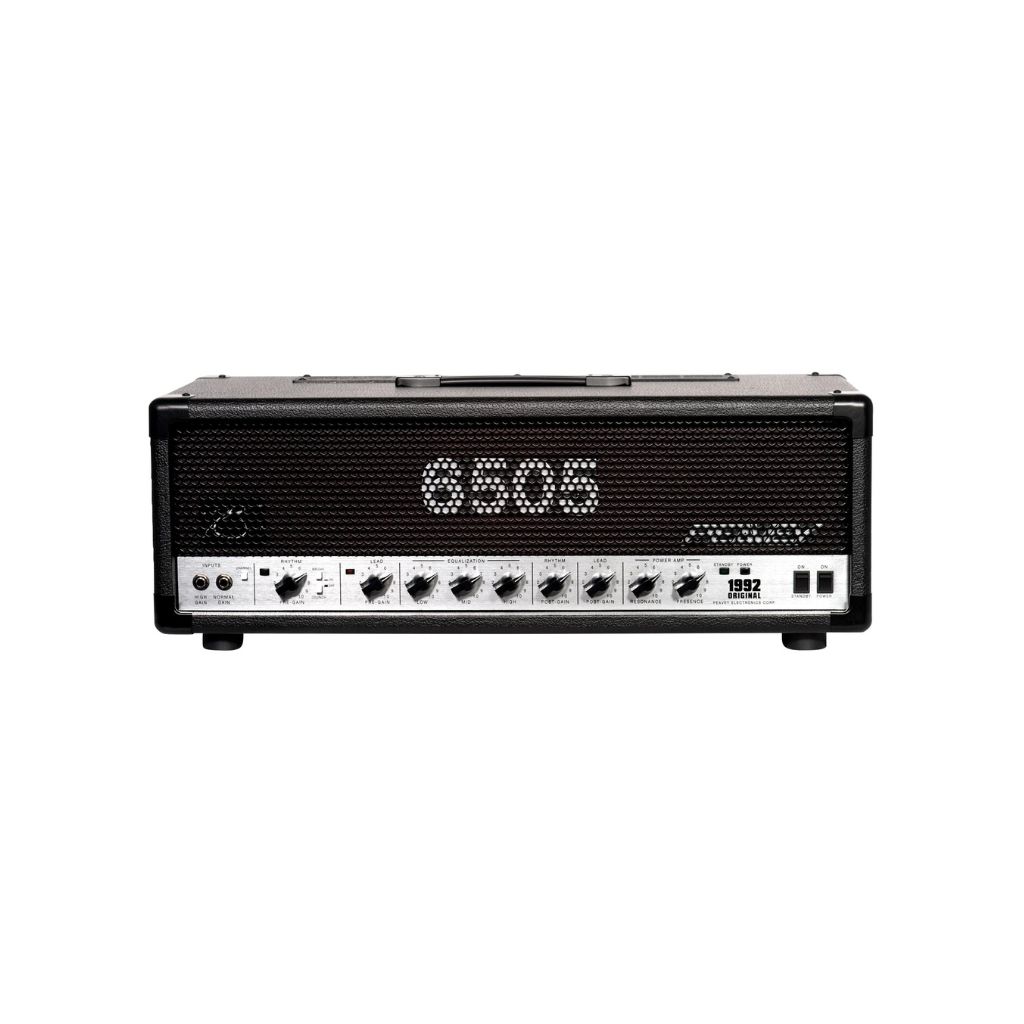Related Tags
A Brief History Of Peavey Electronics
It’s one of the most recognisable amp and PA brands in the world, and was at one time America’s biggest guitar maker… but it all began nearly 60 years ago…

Eddie Van Halen onstage in 1998 with a Peavey Wolfgang guitar. Image: John Atashian/Getty Images
Peavey Electronics was founded in 1965 in Mississippi by Hartley Peavey, just one year after graduating from Mississippi State University. Hartley had played in bands at college, but it didn’t take long for him to turn his attention from entertaining frat parties to building amplifiers.
- READ MORE: Blackstar HT-20RH MK III review: the gigging amp staple becomes a versatile recording tool
In fact, Peavey had been making amplifiers since 1957, and most of the amps and PA used by his band were hand-built by the ambitious young man. Like many young men of this era, Peavey’s first dream was to be a rockstar, but when it became apparent that this wasn’t going to happen, he turned his attention to another way he could keep music the focal point of his life – making amps. He soon began building single-unit bass and guitar amps and selling them out of his father’s store.
The first Peavey-branded amplifier was actually produced in 1961, and it sported the same instantly recognisable logo that’s used by the company today. In 1964, Hartley received his first patent (of the 180 that the company now owns) for a 35-watt solid-state amplifier design. The prototypes used germanium transistors, but he swapped them out for silicon, which were much more durable and dependable.
Before long, people started to realise that this kid’s amps sounded really good. Business picked up to the point where he had to hire employees to help, this was largely due to the help of a man named Don Belfield who sold amps on Hartley’s behalf. In the early days, Peavey was able to produce about one amplifier per week.
Then in 1968, he introduced the PA-3 – one of the first affordable and portable PA systems. In an era where few venues had their own PA system, it was an instant and overwhelming hit with small bands and venues, and demand was so high that later that same year Peavey took out a $17,000 (equivalent to over $150,000 today) loan in order to build a factory that could produce the PA-3 in quantities required.
Looking After The Pennies
By 1972 the company was churning out 2,000 PA units per month, and the systems could be found all over venues in Nashville. The company quickly added two more factories over the next decade or so. Despite being the head of what was now a large and thriving company, it didn’t diminish Peavey’s hands-on approach, nor his eye for detail.
“Ever since then, I’ve tried to do it all by myself. One thing about Peavey is that we owe the bank nothing,” he said in 2011.” Over the years, I have borrowed tens of millions of dollars, but I’ve paid it all back. I go out on the factory floor and I see a resistor on the ground, I pick it up. That’s a penny to me. You see a penny on the ground, you pick it up.”
It wasn’t just PA systems that were earning a good reputation either – Peavey’s amps were quickly becoming prized for their blend of good tone and affordable prices. In 1973 Peavey came out with its Classic series of amplifiers, and it was a very apt name – the Classic has remained a key part of the company’s range ever since, and remains a popular budget amp to this day.
But it wasn’t all smooth sailing for Peavey at this time – ambitious, upstart brands don’t tend to be welcomed into any industry, and it was no different with the guitar world of the 60s and 70s. Indeed, it was even alleged that the big guitar brands were threatening to pull their guitars out of stores if their amps didn’t outsell Peavey’s in this period.
Guitar Star
But rather than see off the threat of Peavey, it only ended up encouraging him. It wasn’t long before Peavey was working on his own line of guitars, to give him similar leverage over stores and dealers as the big guns had. And as a modern and forward-thinking maker on the amp side, Peavey soon became a guitar innovator too.
Hartley had been sketching guitar shapes and designs since high school. In 1977, Peavey released its first guitar model, the T-60 which was the first instrument built using CNC technology. Remarkably, by 1978, Peavey was the largest producer of guitars in the US.
Despite the rapid growth of the company, Peavey always insisted that the brand’s primary focus should be on beginners and affordable instruments. Peavey always retained a focus on making products appealing to beginners. In 1980, they released a series of small, durable practice amplifiers. They were solid-state but had circuitry designed to emulate the sound and response of tube driven amplifiers. The company would later expand on this idea with their TransTube circuits.
The brand also invested in music education, offering classes on pro audio as early as 1975, and teaching people how to use their PA systems.
Despite this beginner focus, Peavey also managed to pick up some notable endorsees in this time – including Neal Schon and Carl Perkins – but the best was yet to come.
Edward Van Halen
In 1992 Peavey launched its biggest and most successful signature product ever – Eddie Van Halen’s 5150. Van Halen was firmly established as the greatest guitarist of his and perhaps any generation by this point, with his legendary ‘Brown sound’ tone the source of much speculation and debate from fans.
The 5150 was a hit, but not just with Van Halen fans – the amp was 120 watts of crushing valve power, and it soon became one of the most common and beloved amps amongst hard rock and metal bands in the 90s.
So popular and significant was the 6505, that Peavey still makes it today – though it was renamed the 6505 after Van Halen ended his endorsement deal with Peavey in 2005 – and it remains hugely popular with 7- and 8-string players especially because of the clarity it offers in the bottom end.

The Van Halen love-in continued in 1996 when Eddie took the signature guitar he’d been making with Music Man for four years, revamped it with the help of Peavey’s Jim DeCola (now the Master Luthier at Gibson), and rechristened it the Peavey Wolfgang.
Various different iterations of the guitar were produced over the next 8 years, before Eddie ended his endorsement deal – the guitar remains in the Peavey line-up as one of its few USA-made instruments, now dubbed the HP-2.
Both the 5150 and Wolfgang are still being made today, now produced under license by Fender for the EVH brand.

Swings & Misses
Peavey has long been a brand famed for pushing the technological envelope, and through the 90s and 2000s it continued to do so with mixed success. In 1995 Peavey released their new TransTube Series, which built on the early solid-state technology used in their practice amps. This technology was employed in the very unique Dweezil Zappa-designed Wiggy Amp model, among others such as the Vypyr and the Bandit series, which has been in constant production, although with incremental updates to the circuitry ever since. If you’re reading this, you’ve probably come across a Peavey Bandit at some point in your guitar life!
In 2009 Peavey bought San Francisco boutique amp and effects maker Budda, and began producing the company’s highly respected valve amps and wah pedals. Peavey was also at the forefront of the amp modelling and amp plugin movement, launching its influential ReValver software in 2008.
It’s not all been smooth sailing however – in 2012 Peavey released the AT-200 self-tuning guitar. As was all the rage in this period (think Gibson Robot tuners and the Line 6 Variax) guitar makers seemed to think that not having to tune yourself was the next great leap forward for electric guitars… this was not the case.
The AT-200’s technology used digital wizardry to effectively autotune out of tune strings on the fly, and was genuinely impressive for the time, but as with all the other automated tuning innovations, ultimately most guitarists hated it. The AT-200 ended up being a huge failure – given the amount of R&D that the technology must have required, this must have stung Peavey, and it’s perhaps unsurprising that the brand has focused on making affordable and unremarkable budget guitars ever since.
The company continues to be active and inventive in the amp world, however – the brand recently teamed up with Periphery main man Misha Mansoor to create the Invective head, which is available in both mini and full-size forms. The year 2025 will mark the company’s 60th Anniversary, and it’s safe to say that Hartley Peavey has done it his way.

